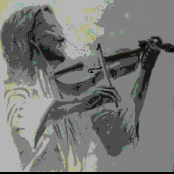Leaderboard
Popular Content
Showing content with the highest reputation on 11/02/2020 in all areas
-
I decided to make a calm and cozy melody because that's fun! 😄 Critique is very welcome!1 point
-
Hello, fellow composers! This is my first topic and first submission for a review of one of my compositions and I'm very excited to share this with you. I work with pen and paper, using a piano for the most part, and only in the later stages of each section of sketchwork do I continue refining the sketches through the Dorico interface. I usually expect to record this with professional musicians in some way or another, so I never spend any time fiddling with the digital performance of the work, to be honest. Because of this, the performance is decidedly robotic, but it still manages to give you an idea of the work as a whole, and I'm sure that your ear and imagination are good enough to be able to realise what it could sound like if it were performed by real, living musicians. (The audio attached is produced by Dorico running NotePerformer 3.) This work was recorded in January 2020 for Signum Classics with Kerenza Peacock (violin) and Huw Watkins (piano) at the Britten Studio in Snape Maltings. Sadly, I can't yet share the audios from that session, since the album will be released in March 2021 for the label's catalogue. Sonata for violin and piano in F major, R. 6 I. Adagio — Allegro assai II. Andante sostenuto III. Allegro con fuoco IV. Adagio ed intimo In my next posts I hope to share work with you that is still in progress so that any input from you will definitely have more weight than at this later stage in the work's life. Oh, I almost forgot! If you're interested in having a score to follow, or if I'm lucky enough that you'd like to perform this work in a recital or concert, please send me a message and I will happily oblige. Wishing you all the best, Rodrigo Ruiz1 point
-
1 point
-
Beautiful piece! I don't see a problem in having two groups of double basses. In fact, I think it gives the piece more depth. And it's coherent with the low register of the rest of the instruments, particularly the violins (except the solo). There are works in which the composers "unbalance" the string ensemble with a purpose. For example Akhnaten, the opera by Philip Glass has no violins. Instead: 12 violas, 8 celli, 6 double basses.1 point
-
1 point
-
1 point
-
1 point
-
thats no problem in my household ... we keep our christmas tree until february 😁1 point
-
it works for me ... gives me time to work on it after the holidays and new years1 point
-
1 point
-
Oh, that's a good point. We'd have to move the deadline for this, I think, @Left Unexplained1 point
-
I'd like to but I don't know if I'll have time to participate. I have a final exam on December 14th and also the 2020 Autumn YC Competition deadline is around the same time right?1 point
-
1 point
-
Thanks! I don't know if I'm THE most prolific LoL - besides, sometimes less is more. But I do feel like I learn a lot from reviewing other people's music but there are plenty of other reviewers on this website who have an unparalleled attention to detail. You yourself are also a very helpful reviewer since you frequently compose pieces inspired by the composers you review. So thanks for that - everyone does their part to make this website a great place I think.1 point
-
Must admit I felt the same as PaperComposer about the bass. It muddies up an otherwise lovely work. Perhaps worse because those very low intervals don't allow a relationship to be established with the harmonies above. Any louder and the acoustic modulation, a beat wave, could become intrusive. So I ask if you've really convinced yourself what parts each DB plays in the harmonic structure. You may have thought it out in detail and well, it's your work, so please disregard that last remark. Otherwise it's an intensely expressive work with what seems excellent harmonic progression and thematic material. Great.1 point
-
Nice expressive string orchestra piece! The only thing I would advise against is having two contrabass parts. Having two different contrabass parts in that low range can give a very muddy sound and my orchestration book advises against even doubling at the octave for contrabasses. Doubling the cello and contrabass an octave apart is much more common and less muddy. Listening on headphones it does sound a bit muddy in the lower range but in this piece it is not as obtrusive because it is slow. In a piece with a faster tempo the low notes wouldn't have very much time to speak and all you'd hear is a momentary muddy texture without clarity. Also, in meas. 46 and 47 those B naturals sound a bit foreign to the mode you'd been using up to that point and afterward. They would sound better as Bb's imo but that's just my opinion. Thanks for sharing!1 point
-
Pleasant, calm...nothing much to criticise. The harmony and tune flow very well. There was another instrument near the beginning, wasn't sure if it was oboe or clarinet. My only crit is the violin should be a little more prominent. As it stands it sounds behind the guitar. Is it possible to move it to front right or something? Nice listen... cheers.1 point
-
Yes, I was sure about that because it's the classic way to transform a melody. But what about taking it as the hexatonic scale that draws the melody, and use it as a mode, building up chords and harmony from that scale only? What about using it as a Pitch Class Set (0,2,4,5,7,9)? What about extracting the rhythmic pattern of the melody and work with it, not with the "melody" itself? What I mean, is to take some feature of the melody and develop an entire piece from it, regardless the melody is easily heard or non at all. No one knows what was the original melody in the Enigma Variations! I'm afraid these options go too far and would make the melody "lost".1 point
-
Ii suspect that "radical" transformations of the melody wouldn't be understood, or allowed.1 point
-
I have no words. I'm not so good at english, let alone English poetry. But the effort you put into this comment/poem (especially not in your own language) only arouses my great gratitude and respect to you and your education.1 point
-
1 point
-
The changes in the dynamics are too extreme for me, surely it is the virtual sound. The melody is nice. But, in general, I like to hear some variation in the left hand.... Yes, only at the end.1 point
-
Sounds pretty practical, what exactly do you think is unrealistic about it? It sounds really good. The sequence beginning around 1:08 is particularly nice, and builds up to a nice climax. I've heard quite a few of your pieces on here, and you're starting to get really good at the things you are good at (lush harmonies, cinematic feel, etc.) I want to try to point out a few things for you to experiment with going forward that might push you out of your comfort zone. I'm not saying anything you're doing is bad, or that you should change it in any way. Rather, this is intended to nudge you in a few new directions that might help you add some new tools to your toolbox, that might supplement what you already have. Experiment with less-frequent changes in harmony, and extend your melodies to get the most out of the unique sonorities you use. You use a lot of chord "loops" that change on a very regular basis (1-2 bars); instead try staying on one harmony for an extended period, like 8-16 bars, and extend your melodies to fully exploit these unique harmonies. Try and add more motion to your melodies. A lot of your melodies tend to be built around half notes and whole notes, try using shorter-value notes, using scales, arpeggios, chromaticism, skips, etc., to add interest. Make use of dynamics and expression CC parameters with your DAW to make the melodies more expressive. It sounds like they are static throughout much of the piece. Try to vary your orchestration and use the different instruments in ways you're not used to using them. Experiment with counterpoint and having multiple melodic lines occurring simultaneously. I could easily imagine a countermelody starting around the 1:30 mark that would add to the drama of this climax. Again, not saying you should stop what you're doing and do this, but rather experiment with adding these to your toolbox; I think these kinds of things might take your music to the next level. I know you're a big Debussy fan, so I imagine you're already familiar with this piece, but I think Prélude à l'après-midi d'un faune showcases alot of these kinds of things. Here's a score video on the off chance you haven't heard it. Thanks again for sharing, it's a very nice piece! I hope you get a chance to post a score, and I look forward to more works in the future.1 point
-
There are a couple of ways you can do it. The first way is within a DAW, after deciding on a tempo, you place markers (find out what the hotkey is in your daw) and place them where you want the "sync points" to be. Then, you adjust your time signatures where necessary to make the sync points land close to or directly on a downbeat. But the better way, and the old way, is that you compose the music in free-time. No metronome, and then adjust the tempo of the midi as needed after the fact. If you use notation, you can set up the video file in the DAW first, place your sync points, but then just compose in notation as you watch the film. At this point, you don't have to worry about it being exactly the right tempo to what you're doing as you're scoring; just approximate. After you finish the cue, load the MIDI of that cue into your DAW. Then, you will be able to visually matchup where the syncpoints need to hit the midi, and you make the tempo adjustments so that it lines up. After you've figured that out, go back to the sheet music and put in matching tempo adjustments. Boom. Sync'd up, and far more organic. In the olden days, how they used to do it, is that the sheet music said which markers a bar was supposed to hit. The syncpoints were also embedded into the copy of the film used during the recording session, so it would visually warn the conductor that the next hit point was coming. So the conductor would just conduct the orchestra according to the timestamps.1 point
-
Works like this prove the point that great music is not limited to a particular point in history. There is as much value in sustaining traditions as there is in originality. I applaud you for sticking to your chosen style in the face of criticism. Had you given in, this work wouldn't exist, and I frankly like this better than much of the music that was actually produced in the Baroque era. Though it is clear that this is written in a Baroque manner, your personal voice is perfectly apparent to me, most of all in the sublime fourth movement.1 point
-
Congratulations on getting this recorded, Rodrigo! I'm happy to hear that the pandemic didn't result in the cancellation of that project. I've previously shared my thoughts on this excellent violin sonata. The fact that much of it sounds really good even in its digital presentation speaks to the strength of the work, and we obviously share an affinity for this style. I'm glad you posted it here. People deserve to hear it.1 point
-
First off, let me say that this is an excellent piece and it was a pleasure to listen to, so thank you for that. It’s good to know that people are still writing in a Classical/Romantic idiom and that performers are still commissioning such works. It gives me some hope for the future. Some notes: In my first play-through, I thought the first movement was in sonata form. But when I went back to analyze it, I found that it is not. While it seems to follow sonata form in its broad outline (there is a slow introduction, a first theme, a second theme, a developmental section, and a sort of recapitulation), the details are anything but conventional. The first and second themes, for example, are both in the same key (F major), and the music that kicks off the “development” section, practically a theme in its own right, returns in the coda (transposed from Ab minor to the tonic). The “recapitulation,” if it really is one, seems to be an apotheosis or rhapsody of the various themes rather than a simple restatement. In the end, I don’t know what form this is, but I like it. And I don’t know if you started with a sonata form and changed things around, or if you just followed your artistic inclinations and ended up with something close to a sonata form, but either way, the results are refreshingly original. You’re obviously someone who knows the rules and is consciously choosing to break them. The second movement begins with an outline of a diminished chord in a contour that Wagner was particularly fond of (especially in his earlier operas), so it’s only appropriate that this section has the feel of a recitative about it. The diminished theme is then transformed into a major key for the ensuing “aria” which, appropriately enough, is accompanied by a pattern frequently found in Schubert’s lieder (not to mention bel canto opera). I think the second movement ends a little too early, but there’s an interesting consequence to its brevity: it makes the second movement sound like a prelude leading into the third movement. Or, to carry through with the aria analogy, it makes the second movement sound like a cantabile to the third movement’s cabaletta. If we think of the second and third movements as a double-aria, then we end up with a traditional, three-movement sonata: Adagio-Allegro (I), Cavatina (Cantabile and Cabaletta) (II), and Adagio ed intimo (III). Interestingly enough, the descending scale that opens the fourth movement is a transformation of the diminished theme that opens the second movement (with octave displacement taking the place of the anguished leap of a sixth). I don’t know if this was intentional or not, but it’s effective. Even though you say that the fourth movement was composed last, it’s actually my least favorite movement. My favorites are the first and the third. The earlier movements call to mind Schumann and Beethoven (particularly the motoric drive of the third movement), while the fourth movement gives the work a sentimental, almost elegiac quality typical of Brahms. Stylistically, I think this piece could pass for something written in the nineteenth century. If you had told me it was by Raff, I would have believed it. Whether it stands alongside the greats like Beethoven, Schumann, and Dvorak is another matter, but the potential is there, so keep writing. Again, this was a great pleasure to listen to, so thanks for sharing (I actually listened to it several times, and always found new details to appreciate). I hope you will post more pieces in the future, but you’re also welcome to message me about any new works you’ve written – I would be happy to review them. Thanks!1 point

.thumb.png.8b5b433a341551e913a34392660bc95b.png)


_Small-3.thumb.jpg.b0a4415d512176e6fbce5cfa1e8ad246.jpg)


